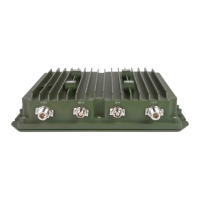1-12
RF-7800W
GENERAL INFORMATION
1.7 ETSI NOTICES (FOR DEPLOYMENTS WITHIN EUROPE)
a. Frequency Band Considerations
Although the radio supports a wide range frequencies, only a subset of bands within this range have
been CE certified. In order to comply with applicable regulations, the radios must maintain specific
configurations.
b. 5.725-5.875 GHz band (ETSI EN 302 502)
• Use of Dynamic Frequency Selection (DFS) is required. Refer to Paragraph 3.8.9.1.
• Only 10 MHz and 20 MHz Channel Widths are allowed. Refer to Paragraph 3.8.5.
• Specific RF center frequencies must be used. Refer to Paragraph 3.8.4.1. Refer to Table 1-11 and
Table 1-12 for example non-overlapping RF Frequencies. The nominal center frequencies are
defined as follows:
(a.) 10 MHz: 5725+(n*2.5) MHz [where n = 2 to 58]
(b.) 20 MHz: 5725+(n*2.5) MHz [where n = 4 to 56]
• In order to ensure that the radio remains on designated center frequencies, e.g. due to a DFS-
induced frequency change, Frequency Ranges must be defined. Refer to Paragraph 3.8.4.4. Refer
to Table 1-11 and Table 1-12 for example non-overlapping Frequency Ranges.
• The Tx Power must be reduced in order to achieve Equivalent Isotropically Radiated Power (EIRP)
limits. Refer to Paragraph 6.4.
Table 1-11. Example RF Frequencies - 10 MHz Channel Width
RF
Frequency
(MHz)
Frequency Range (MHz)
Begin End
5730 5725 5735
5740 5735 5745
5750 5745 5755
5760 5755 5765
5770 5765 5775
5780 5775 5785
5790 5785 5795
5800 5795 5805
5810 5805 5815
5820 5815 5825
5830 5825 5835
5840 5835 5845
5850 5845 5855
5860 5855 5865
5870 5865 5875

